Goh Chok Tong was formally sworn in as the second Prime Minister of Singapore 27 years ago today, on November 28., 1990, and served as PM until 2004.
During his time as PM, besides building up his distinctive style of leadership domestically, he was also active on the diplomatic front, safeguarding Singapore's strategic interests regionally and internationally.
His role as an international statesman helped to expand Singapore's political and economic space, and his interactions with various notable leaders from all over the world played a crucial role in maintaining and building up Singapore's relations with other countries.
Here are some of them.
Mahathir Mohamad, Malaysia
In the 1990s, ties between Singapore and Malaysia were strained because of arguments over the location of a border post and the cancellation of automatic flyover rights for Singaporean military aircraft using Malaysian airspace.
In 1998, Malaysia PM Mahathir even said that it will be difficult to be friendly again with Singapore.
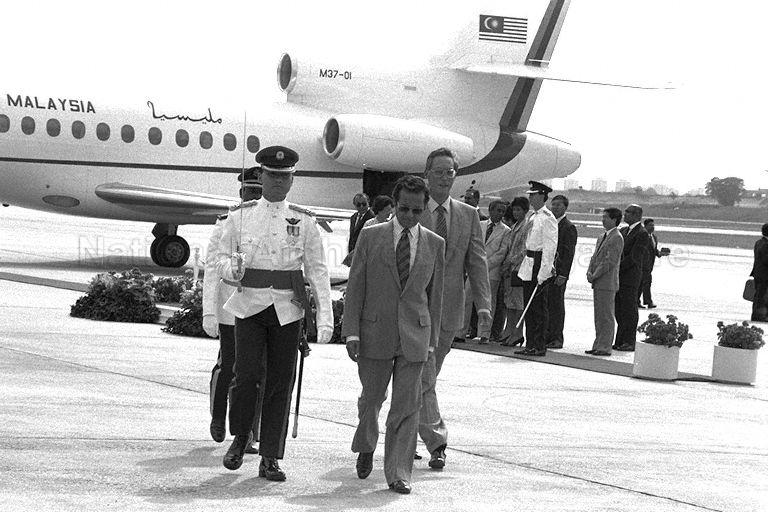 Photo from NAS.
Photo from NAS.
However, in Nov. 1998, Goh and Mahathir met up and agreed to improve ties. It was the first meeting between the two countries since relations started to deteriorate rapidly earlier that year.
At that meeting, the two also agreed that their officials would curb heated attacks on each other, paving the way for a better bilateral relationship between both countries.
Five years later in 2003, when Goh commented on his working relationship with Mahathir, he stated that they "[got] along well":
"When we meet at conferences, obviously the relationship is better than cordial, we get along well. But when you have issues, he would have to protect Malaysia's interests and I certainly would have to protect Singapore's interests. So on different positions, we take different approaches to solving a problem."
Bill Clinton, USA
Singapore's economy was affected by the Asian Financial Crisis in the late 1990s, and it became crucial for Singapore to pursue bilateral free trade agreements (FTA) with important players such as the US.
However, talks with the US proved to be tricky. After the Michael Fay incident in 1994, the White House administration kept Singapore at arm's length to express the US' displeasure.
In order to bypass the White House gatekeepers, US President Bill Clinton invited Goh for a game of golf in Vancouver in 1997, after learning of the situation through a mutual friend.
At the APEC Leaders meeting in Brunei in November 2000, Goh reached out to Clinton over a late night golf game about a bilateral FTA.
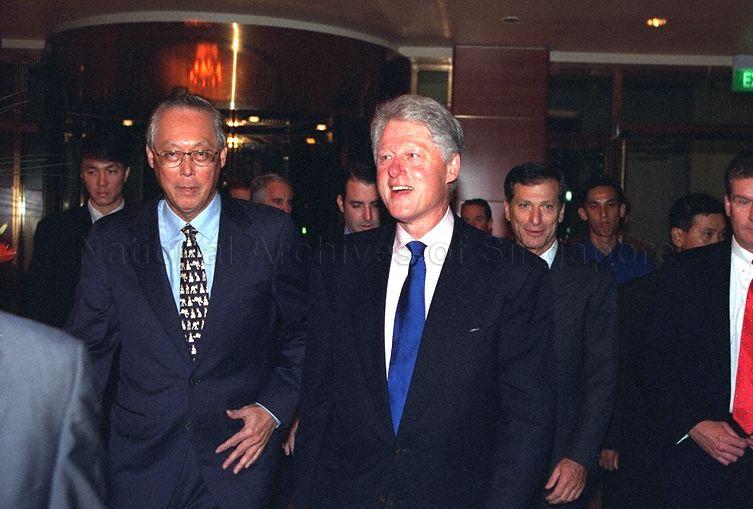 Photo from NAS.
Photo from NAS.
According to an account by Goh,
"We played 18 holes. After we had finished at about 2.00 am, I made a pitch for a USSFTA. My argument was a simple one. The FTA would signal strongly the US' strategic interest in Asia and anchor the US in Asia. He said that it was worth doing so we agreed to launch the FTA, all in under 20 minutes."
The game of golf was a strategic move not only for US-Singapore's economic relationship, but was also crucial for restoring bilateral relations following the Michael Fay episode.
[related_story]
Wen Jiabao, China
With the outbreak of severe acute respiratory syndrome (SARS) in 2003, ASEAN leaders met with Premier Wen Jiabao in Bangkok to discuss the impact of SARS.
Goh was scheduled for a visit to China, however, he cancelled the visit in April 2003 on the doctor's advice.
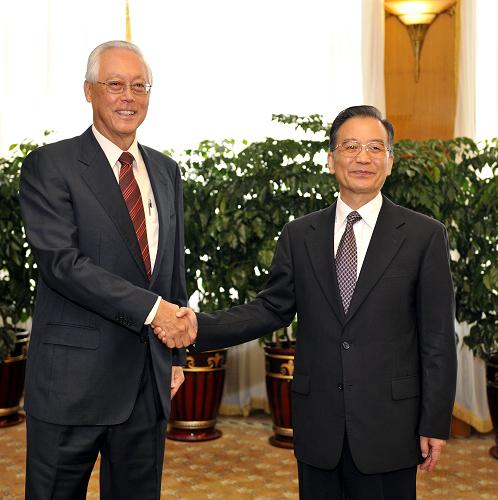 Photo from Ministry of Foreign Affairs of the PRC.
Photo from Ministry of Foreign Affairs of the PRC.
[related_story]
Despite the cancellation, Singapore's bilateral relationship continued to be built up steadily.
In May 2003, Goh sent a follow-up letter to Wen, reinforcing points of cooperation between Singapore and China. In his letter, he stated several measures signalling Singapore's commitment to China's continued economic growth:
"Other Singapore agencies are working with the WHO to provide SARS test kits and training to SARS-affected areas, including China. In addition, Singapore is sending two thermal scanners to Beijing Capital Airport for its use. Singapore companies led by Temasek Holdings will also be providing ventilators and thermal scanners (in addition to the two being sent over now) to support China's fight against SARS."
Additionally, Goh and Wen also launched the Joint Council for Bilateral Cooperation (JCBC) in November 2003.
The JCBC is the highest-level institutional mechanism for bilateral cooperation, and is unique because it is unlike other bilateral mechanisms China has with other countries.
Vo Van Kiet, Vietnam
In 1987, Vietnam transitioned away from a centrally planned economy and opened up to international trade and foreign investment.
One project that resulted from Vietnam's conversion was the Vietnam-Singapore Industrial Project (VSIP), where economic cooperation between Singapore and Vietnam was fostered.
VSIP was first proposed by then-PM of Vietnam, Vo Van Kiet, to Goh Chok Tong in March 1994.
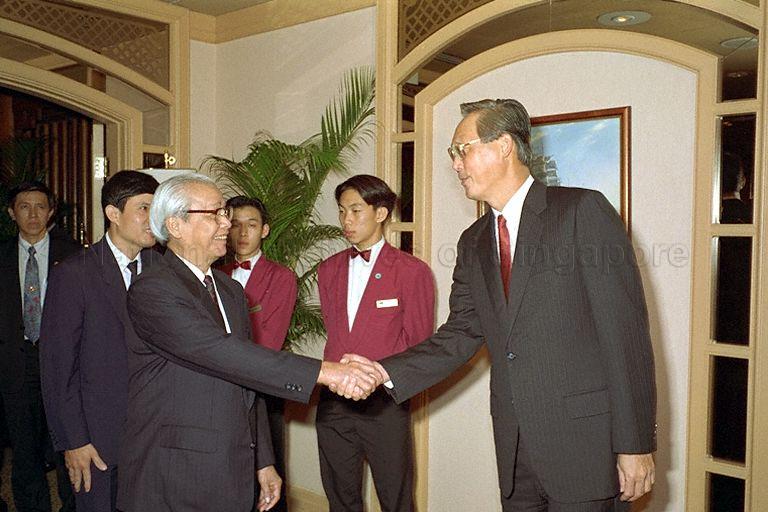 Photo from NAS.
Photo from NAS.
The project was eventually launched in 1996, and today, it has become one of the largest developers of integrated industrial parks and mixed-use areas in Vietnam.
This initiative signalled the extent of Vietnam-Singapore economic collaboration, and has continuity even up until today.
Robert Mugabe, Zimbabwe
 Photo from NAS.
Photo from NAS.
In the 1990s, Singapore was looking beyond traditional markets and sensed the untapped potential of Africa. With the end of apartheid and the resolution of armed conflicts in South Africa, Zimbabwe was seen as a prime link between African and Asian economies.
In 1995, Goh hosted Robert Mugabe, then-President of Zimbabwe. It was Mugabe's first official state visit to Singapore with Goh Chok Tong serving as Prime Minister.
In his 1995 speech, PM Goh called Mugabe "a good friend," and included details on how there is scope for Singapore businessmen to "expand their interests to Zimbabwe."
 Photo from NAS.
Photo from NAS.
Multilateral engagements
Wishing to strengthen political, economic and socio-cultural links between Asia and Europe, Goh also proposed the creation of an international forum known as the Asia-Europe Meeting (ASEM).
ASEM initially consisted of 15 member countries of the European Union, seven ASEAN members, China, Japan and Korea.
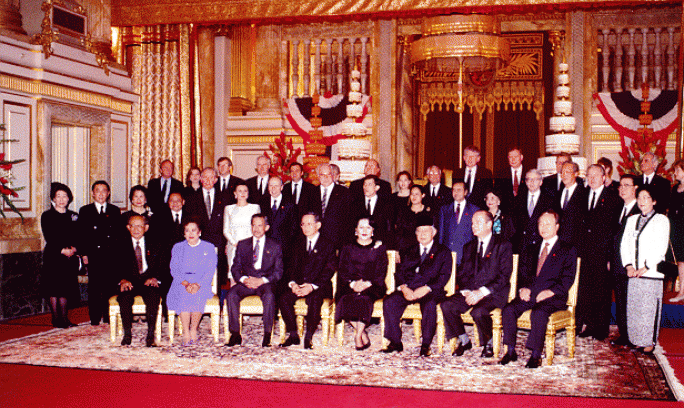 Photo from ASEM Infoboard.
Photo from ASEM Infoboard.
In 1996, they held their first meeting to discuss possible avenues for economic and political cooperation.
More importantly, this summit also paved the way for the establishment of the Asia-Europe Foundation (ASEF) one year later in 1997 to promote greater mutual understanding between Asia and Europe through intellectual, cultural and people-to-people exchanges.
Top photo from NAS.
If you like what you read, follow us on Facebook, Instagram, Twitter and Telegram to get the latest updates.